Motichur laddu are soft, delish melt in the mouth ladoo made mainly with gram flour, sugar, and spices. The gram flour batter is fried to make tiny balls or boondi and mixed with sugar syrup, nuts or seeds and later shaped to neat round balls. Motichoor ladoo is a popular sweet from the North Indian cuisine and often made during festivals or celebrations. Here I share my detailed step-by-step photos to make these soft, tender and tasty homemade laddu recipe from scratch.
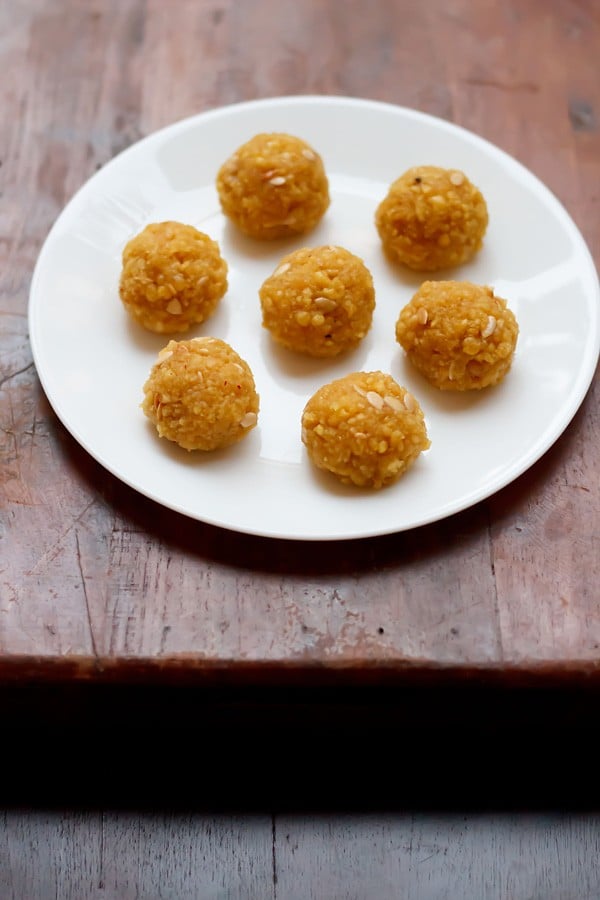
Table of Contents
What is Laddu or Ladoo
The term laddu or ladoo is for sweetened round balls made from flour, sugar and ghee or oil. Some nuts and flavorings are also included. Indian cuisine has a variety of laddu recipes made with unique ingredients and different cooking methods.
Mostly the flours that are using to make laddu are gram flour, semolina (rava), whole wheat flour, various millet flours, lentil flours, rice flour and ingredients like coconut, flattened rice, dry fruits, seeds and nuts.
They are usually made for major Indian festivals like Diwali, Ganesh Chaturthi, Raksha Bandhan or for any celebrations like weddings, engagement, birthdays etc and also for religious pooja ceremonies.
Laddu is offered to many Indian gods and goddesses. They are also made specially for Bhagwan Ganesha during the festival of Vinayaka Chaturthi. Many Indian temples offer ladoo as prasad to the devotees.
One of the most famous ladoo, we have had as Prashad, are from the Tirupati temple in Andhra Pradesh, India. Another prashad, we look forward is the boondi ladoo from Shirdi sai temple, Nasik, India.
Whenever we want to make any food for deities then refrain from tasting or smelling the food. Prepare the food with a lot of devotion, cleanliness and a peaceful state of mind.
About Motichoor Ke Ladoo
In the Hindi language, the word ‘Moti’ means pearl and ‘Choor or Chur’ means to crush or crumble. Literally translated to crumbled pearls. Actually, when you hold this ladoo in your hand and even apply a little pressure, they crumble. They are so soft and delicate that while eating also they fall apart.
The hero ingredient here is gram flour. It is also known as besan in Hindi and made from skinned black chickpeas. Note that the gram flour is chickpea flour in the sense that chickpea flour is made with white chickpeas. For the recipe use the finer variety of gram flour and not the coarser variety.
The recipe is time intensive but not difficult. You will need certain equipment to make this laddu as I have shown in the stepwise photos. I have not purchased anything special and made use of what I had in the kitchen. Most of these equipments can be easily found in an Indian kitchen.
Generally the motichur ladoo that you get in mithai shops (sweets shops) have green, red or orange color boondi in the ladoo. For that they make extra batches of colored boondis with artificial colors. Here I have used saffron as a natural coloring agent. I try to avoid artificial coloring agents as far as I can.
If you plan to make the motichur laddu, for any deity or for pooja, then I do suggest adding a pinch of edible camphor in them. You can also fry the boondi in ghee. Generally, most food offered for bhog or naivedyam, are made in cow’s ghee. Desi ghee has a satvik quality and hence used for religious purposes.
If you have a pooja or any religious activity at home, then these motichur laddu, can be given as prashad to the devotees. Usually, four small ladoo are given in one pack.
Difference between Motichoor ladoo and Boondi ladoo
The major difference between Boondi ladoo and motichoor ladoo is the size of the tiny boondi or fried gram flour balls. Boondi ladoo has the gram flour balls bigger in size and motichoor ladoo has smaller ones.
Both the ladoo are made from gram flour or besan batter. The batter is poured through a ladle or sieve with perforations and these give rise to round shaped droplets, called as boondi (derived from the word ‘boond’ in Hindi which means water droplets).
There are two types of boondi ladoo. One is a soft textured one and the other is a crisp hard one. Both these ladoo varieties have some variations in the method, thus yielding different textures.
Making motichoor ke ladoo is easy but time-consuming. I already know the process as I have seen Halwais (traditional sweet makers) preparing the ladoo a couple of times. I have a photographic memory so I still remember the whole process in my mind. But for finer details and points, I asked my mother-in-law and referred to Lavi’s post Here.
The whole process of making the motichur laddu took a lot of time and in between, it started becoming dark. By the time, I was finished, it was already dark. The laddu were so good, we could not resist having them.
So after some ladoo were over, I took the photos the next day of the remaining laddu. Again next day, with a lot of things happening during the festive occasion, I ended up taking the final photos just before sunset. Hence the final photos have not come out well.
Thus, I was not sure of adding these motichur laddu recipe on the blog. Two days back, my husband bought some motichur ladoo from a famous mithai shop nearby and asked me to taste it and compare with the ones I had made.
We came to a conclusion that the homemade motichur laddu were much superior in taste, texture and flavor than the mithai shop ones. I don’t want to boast but that was our genuine feeling.
The laddu made at home were more softer and tasty. So my husband told me, don’t deprive your readers from this delicious motichur laddu recipe. What hubby said, made sense and so I am adding the motichoor ladoo recipe post. I hope you enjoy making them and eating them.
How to make Motichoor Laddu Recipe
Making Sugar Syrup and Batter
1. Dissolve sugar, saffron threads and water in a pan and keep it on the stovetop to prepare the sugar syrup. Keep on a low to medium-low heat to cook the sugar solution.
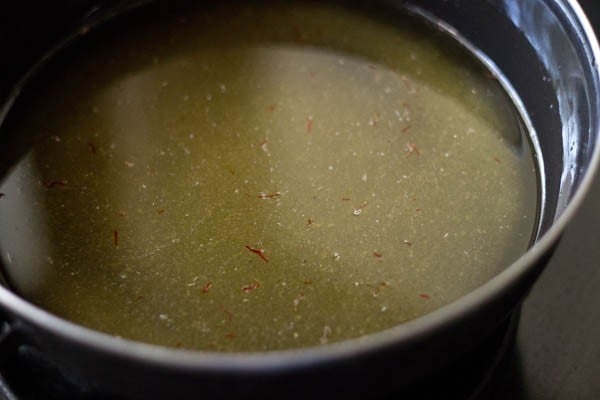
2. Make a smooth flowing batter of the gram flour/besan, crushed saffron and water. The batter should neither be thick nor thin. It should be a flowing batter as shown below.
The amount of water to be added depends on the quality of the gram flour. So you can add more or less than, what is mentioned in the recipe.
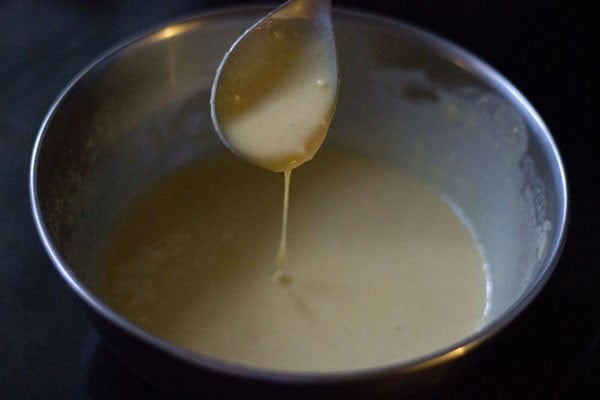
3. In the below photo the sugar solution is simmering. Stir at intervals.
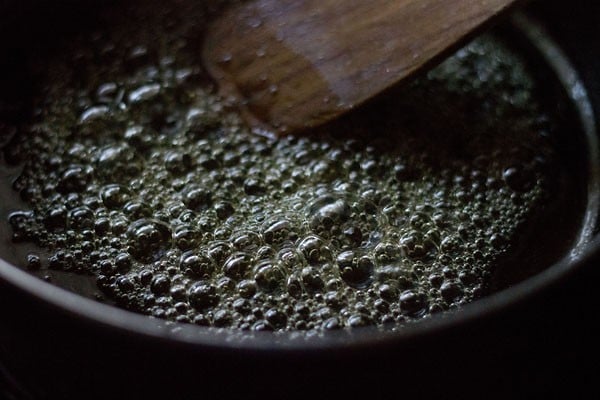
4. Cook the sugar syrup till you get one thread consistency in it (see the photo below showing one thread consistency) and then switch off the heat. Remove the pan from the stovetop and set it aside on your kitchen countertop.
Remember that the sugar syrup should be hot when you add the boondi to it. So you can keep the sugar solution in a hot water bath. Meaning place the pan on a plate or tray filled with hot water. This will keep it hot without crystallizing it.
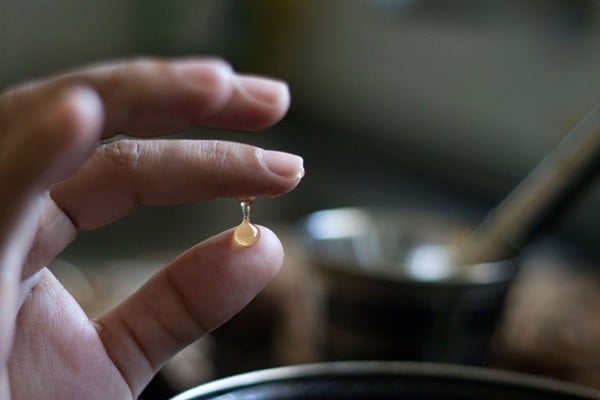
Making Boondi
5. Heat oil for deep frying in a kadai or pan. The oil has to be moderately hot. When you add one or two drops of the gram flour batter, they should come up briskly but steadily on the surface.
If they come up very quickly, then the oil is very hot. If they don’t come up or take time, the oil is not enough hot.
Take a perforated ladle/spoon. With your hands position the ladle above the oil. You will need one more large ladle/jhara to remove the fried boondis.
Remember to fry the boondi in a medium-hot oil or a moderately hot oil. If the oil is warm, the boondi will soak more oil, getting loaded and soggy with it.
If the oil is very hot, the batter will get more browned or even burnt becoming very crispy.
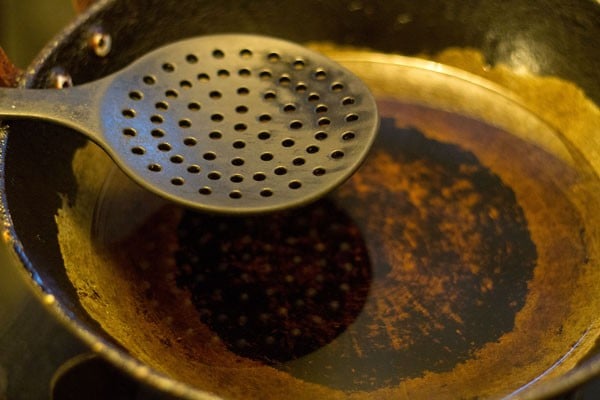
6. Take a large spoon of the besan batter and pour it on perforated ladle/spoon. Press with the other spoon so that the batter falls down from the perforations into the hot oil.
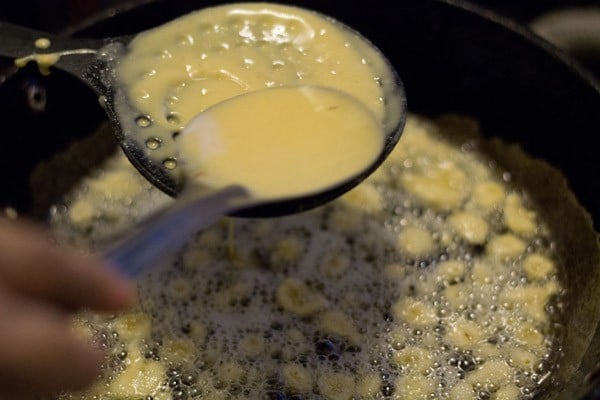
7. Fry the boondi (gram flour balls) till they become golden. Don’t over fry or make them crisp. When the oil stops sizzling, remove the boondis.
About 45 seconds to 1 minute is enough to get the correct texture in the boondi. This step is important because if boondi becomes crisp then motichoor laddu won’t be soft and they won’t be able to absorb the sugar syrup.
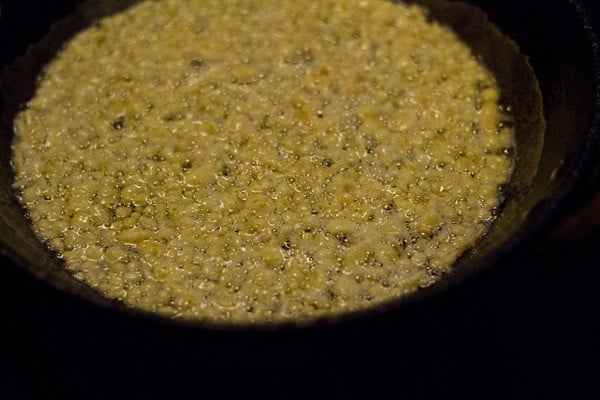
8. For collecting the fried boondi use a large slotted spoon/jhara. Drain the oil very well after removing the boondi and then add them directly to the sugar syrup.
Also, note that the sugar syrup should be hot. If the sugar syrup is not hot, then just heat it. In case, the sugar syrup crystallizes, then reheat again mixing 1 to 2 tablespoons water. No need to bother about the flat or tailed boondis as we will be pulsing them in the blender later.
Fry the boondi in batches this way and keep on adding them after draining the oil very well to the hot sugar syrup.
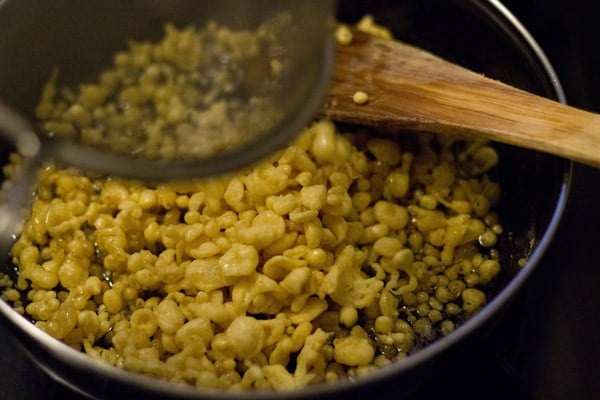
9. Make all the boondis like this and keep on adding boondis immediately to the sugar syrup. Stir and mix well. The boondis should get softened in the sugar syrup.
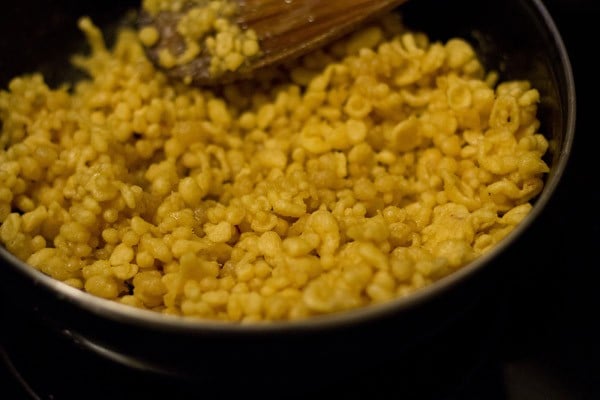
Making Motichoor Laddu
10. In a blender or mixer add all of the boondi that has been mixed with the sugar syrup. Add 1 tablespoon of hot water and pulse the boondi mixture a few times to get a smaller shape. Don’t pulse too much otherwise you won’t be able to shape the motichoor laddu easily.
The amount of water to be added depends on the texture of the boondis. If the boondis are a bit crisp, then add 1 or 2 tablespoons more of the hot water. The boondis absorb the hot water and remain soft and moist.
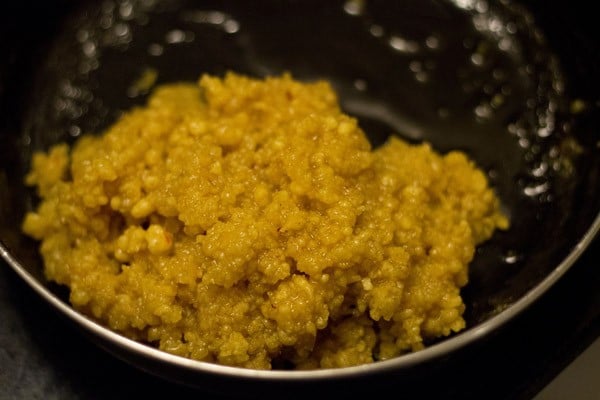
11. Add the magaz (melon seeds) and black cardamom seeds. Mix well.
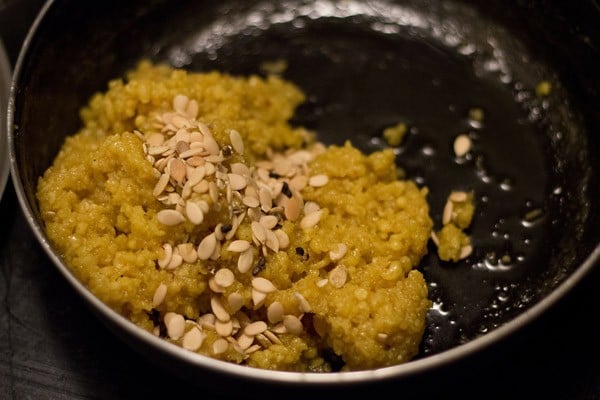
12. Apply some oil or ghee on your palms and shape the ladoo. The mixture would be warm when preparing the laddu. On cooling they become firm.
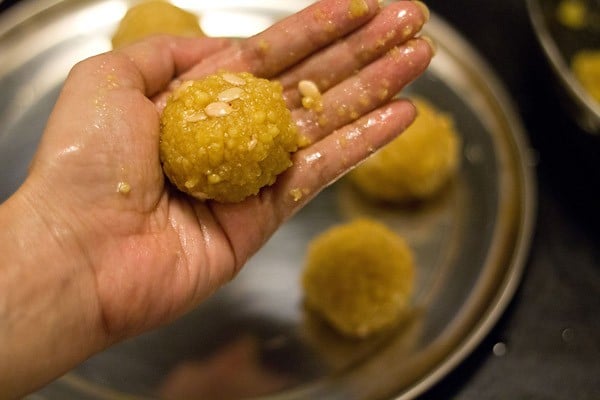
You can garnish them with melon seeds/magaz or raisins or nuts like almond or pistachio slivers. These ladoo can also be refrigerated.
If you fry them in ghee then the ghee will solidify on refrigeration and some softness is lost. Enjoy them as soon as they are made and store leftovers in the refrigerator.
For more sweets recipes you can check this post sharing 121 Sweets for Diwali festival.
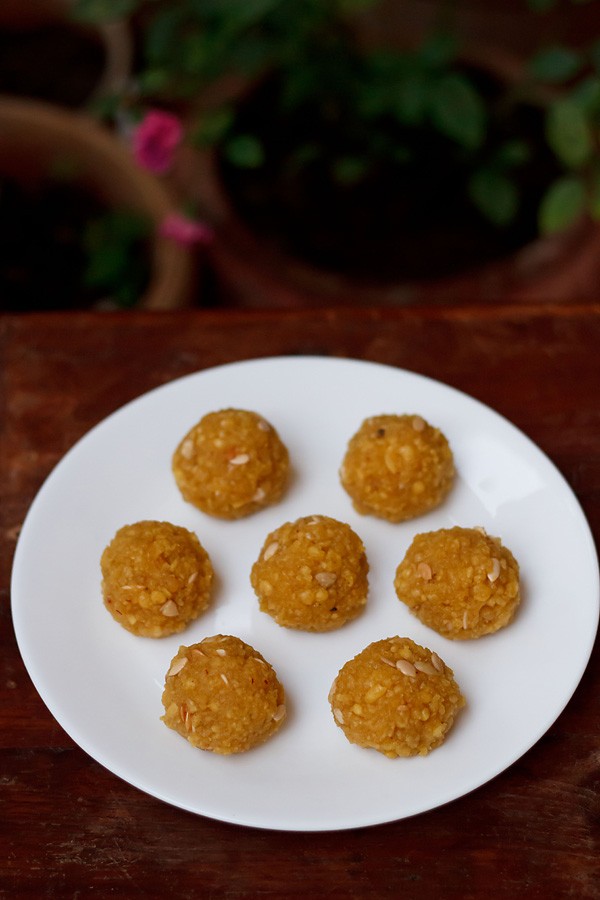
Recollecting the important points to make Motichoor Ladoo
- The batter should be smooth flowing and without lumps and of medium consistency.
- One thread consistency in sugar solution and keep it hot.
- Don’t over fry the boondis or make them crisp. They should be soft and cooked and not crisp.
- Sugar syrup should be hot when you add boondis to them.
- Add fried boondis immediately to the sugar syrup.
- Don’t pulse the boondis too much in mixer. Otherwise you won’t be able to shape the motichur ladoo easily.
If you are looking for more Ladoo Recipes then do check:
Please be sure to rate the recipe in the recipe card or leave a comment below if you have made it. For more vegetarian inspirations, Sign Up for my emails or follow me on Instagram, Youtube, Facebook, Pinterest or Twitter.
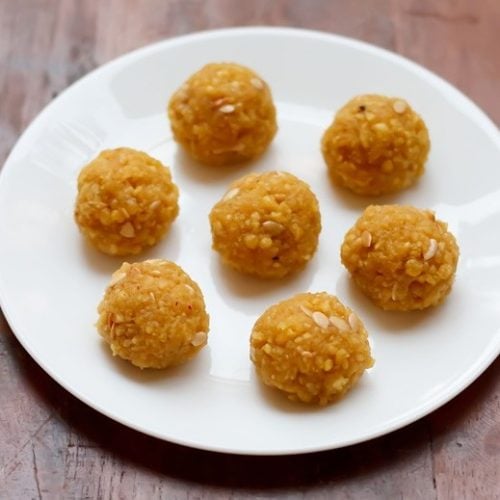
Motichur Laddu (Motichoor ke Ladoo)
Ingredients
For sugar syrup
- 1 cup sugar
- ½ cup water
- a generous pinch of saffron powder or crushed saffron (kesar)
For making boondi
- 1 cup besan (gram flour)
- a generous pinch of saffron powder or crushed saffron (kesar)
- ¾ cup water
- 2 to 3 black cardamoms – seeds removed and the skins discarded
- ½ tablespoon magaz (melon seeds)
- oil for deep frying
- a bit of oil or ghee for applying on the palms while shaping the ladoo
Instructions
Preparing sugar syrup
- Dissolve sugar, saffron threads and water in a pan and keep it on the stove top.
- Cook the sugar solution till it reaches one thread consistency (check step 3 pic to see photo showing one thread consistency) and then switch off the flame. Keep the sugar solution aside.)
Making boondi
- Make a smooth flowing batter of the gram flour/besan, crushed saffron and water. The batter should neither be thick nor thin. It should be a flowing batter without any lumps. The amount of water to be added depends on the quality of the the gram flour. So you can add more or less than what is mentioned in the recipe.
- Heat oil for deep frying in a kadai or pan. The oil has to be moderately hot. Take a perforated ladle/spoon. With your hands position the ladle above the oil. You will need one more large ladle/jhara to remove the fried boondis.
- Take a large spoon of the besan batter and pour it on perforated ladle/spoon. Press with the other spoon so that the batter falls down from the perforations into the hot oil.
- Fry the boondi (gram flour balls) till they become golden. Don’t over fry or make them crisp. When the oil stops sizzling, remove the boondis. About 45 seconds to 1 minute is enough to get the correct texture in the boondi.
- This step is important because if boondi becomes crisp then motichur laddu won't be soft and they won't be able to absorb the sugar syrup.
Making motichoor ladoo
- For collecting the fried boondi use a large slotted spoon/jhara. Drain the oil very well after removing the boondi and then add them directly to the sugar syrup. Also note that the sugar syrup should be hot.
- If the sugar syrup is not hot, then just heat it. In case, the sugar syrup crystallizes, then reheat again mixing 1 to 2 tablespoons water. No need to bother about the tailed or flat boondis as we will be pulsing them in the blender later.
- Make all the boondis like this and keep on adding them immediately to the sugar syrup. Stir and mix well. The boondis should get softened in the sugar syrup.
- In a blender or mixer add the boondi and the sugar syrup. Add 1 tablespoon of hot water and pulse the boondi mixture for a few times to get a smaller shape.
- Don't pulse too much otherwise you won't be able to shape the motichur laddu. The amount of water to be added depends on the texture of the boondis.
- If the boondis are a bit crisp, then add 1 or 2 tablespoons more of the hot water. The boondis absorb the hot water and remain soft and moist.
- Add the magaz/melon seeds and black cardamom seeds. Mix well.
- Apply some oil or ghee on your palms and shape the motichoor ladoo. The mixture would be warm when preparing the laddu. On cooling they become firm.
- You can garnish the motichoor ladoo with melon seeds/magaz or raisins. These motichur ladoo can also be refrigerated since they are not made from ghee. If you fry them in ghee then the ghee will solidify on refrigeration.
Notes
- Use a finer variety of gram flour and which is in its shelf life. Do not use gram flour that has got rancid.
- Remember to keep the sugar syrup hot by placing the pan over a bowl or pan of hot water.
- Don’t over fry the boondi. They should not become crisp.
- While blending do not pulse too much as the ladoo mixture will become pasty and won’t have the fine boondi in it.
- Fry the boondi in a medium hot oil. If the oil is warm, the boondi will soak more oil and become soggy with it. If the oil is very hot, the boondi will become crisp too soon and get too much browned or burnt.
- For a vegan motichoor laddu, use a neutral flavored oil to spread on your palms while shaping ladoo.
- The recipe can be scaled easily to make a small or large batch of motichur laddu.
Nutrition Info (Approximate Values)
This Motichur Laddu recipe post from the blog archives (first published in July 2014) has been updated and republished on 2nd July 2021.
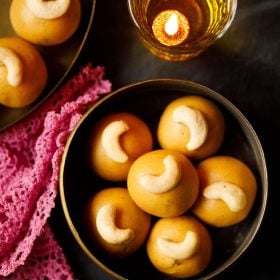
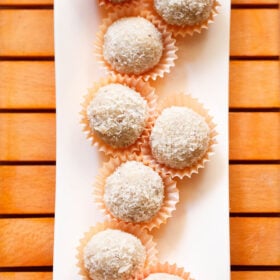
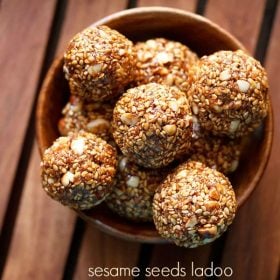
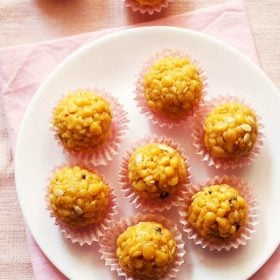








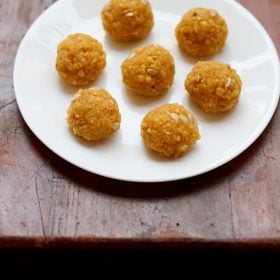
Thank you so much 👍 awesome recipe ❤️
Welcome and thanks.
Hi Dassana,
Thanks for an amazing recipe! Actually my son insisted to make these laddooes when I was going through your recipe. I tried it out and it turned out to be really delicious! But I also had a small problem while making those bundies. Using Jara when I was making bundies, there were lumps also! I tried with thicker batter also but it happened again. Though I was not worried that much as we were going to churn it in the final step!
But like you, even I love cooking and anything imperfect hits my head and I can’t get over with it until it is done perfectly!! So writing to you.
Hope will be able to understand the mistake I must have made while making those bundies!
I am following your recipes since 3-4 years and I am a big fan of yours.
Hi Ami, thanks for writing and yes I can understand. When mixing the batter use a small wired whisk as it really helps in dissolving small tiny lumps. Sometimes there is more moisture in the besan and this leads to lumps when mixing. You can sift the besan a couple of times before making the batter. You can even lightly roast the besan.
The stickiness in the lumps is due to the fact that most manufacturers use dried white peas flour in besan. Besan made with only chana dal won’t give troubles with the lumps. I used to grind chana dal in a local mill for making besan. I lightly roast the chana dal to get rid of moisture if any and then would be given to grinding in a local chakki. Trust me the pakoras or any dish you make with this homemade besan is much better than store-brought besan and does not even get lumps while mixing. I hope this helps.
Thanks a lot.
Hi Dassana , Thankyou for this recipe.I have made this many times and its always a hit.
Thanks for letting me know. Glad to read the feedback. Thanks for the rating too.
Hi, all your recipes are too good.. I tried it and the batter formed lumps when dropped in oil.. what could be the reason for that ?
thank you. while frying, the oil needs to be hot. if the oil is not hot, then lumps will form. another reason could be that the batter was more thin. this can also result in lumps. hope this helps.
Great recipe! Everyone loved it and thank you so much for sharing 🙂
Hi this is a great recipe but I just have one issue, once the ladoos are prepared the sugar crystalize so when eating the ladoo I can taste sugar pieces also.
thanks. if the sugar solution has been cooked too much and beyond 1 thread sugar consistency, then the sugar will crystallize on cooling. hope this helps.
Amazing recipe
The ladoos are so delicious????
Even better than store brought ladoos
The people whom i served
Said they have never had such good ladoos
Thanks for the recipe amit????
thank you arjun for this wonderful feedback and the rating on motichoor ladoo. glad to read it. welcome and happy cooking.
Hi! Your husband was right, I’m glad you posted it. It is great and I made perfect bundi laddus with it!
You made a difficult recipe very easy. Thank you and god bless you for all your efforts.
I tried before to post my thank you, I don’t know what goes wrong, it does not get posted.
Welcome Uma. Thanks for your positive feedback and best wishes. The comment goes for moderation and we usually respond to it within 48 hours.
Hi,
Thank-you for the detailed and stepwise recipe.
I tried out and it came out well though it became little watery when added water. Is it necessary to put water?
But my family loved it. Going to make it again this time in desi ghee.Thank-you soooo much.
Ardent fan of you n your site.
thanks a lot roli. just a bit of water needs to be added. water helps in the boondi sticking to each other, so that the ladoos can be shaped easily. so next time you can just sprinkle a bit of water.
Hi i dont know your name but i keep trying your recipes from three months your recipes are so good and your explanation also very clear to understand thanku for helping me in cooking .
Thanks a lot Sowjanya for your positive feedback. My name is Dassana Amit
Hi dassana , Happy Diwali to u n ur family.
Yesterday I tried motichur laddu n they were just mouth melting ur recipe steps were really helpful n once again thanks a lot for sharing detailed recipes .
Also just one step which I took from other site is that when we get one strand sugar consistency put little lime juice over it to avoid formation of sugar crystals n this was also helpful.
bhavana, wish you and your family a happy diwali. thanks for the feedback on the motichoor ladoo recipe. yes lime or lemon juice does help in stopping the sugar crystal formation. you can use this method when making any sugar syrup, even for gulab jamuns.
Hi dasana, I tried them yesterday, just want to clarify few things, I had put the sugar syrup in hot water bath, but still noticed some crystallization whilst adding boondi, so I reheated the boondi mix , also could feel bit of rawness in boondi , though I cooked it till oil stopped sizzling, adding 2tbsp of water made the mixture, more watery after pulsing diifficult to roll..
Please help, as I want to try again soon
fine sonia 🙂 depending on the size and depth of the pan, there can be some crystallization. some more water can added to almost cover the pan from outside till 2/3rd or 3/4ths, so that the sugar at the sides does not crystallize. at what temperature of oil you fried boondi? on a high flame or high temp in the oil, the boondi will quickly cook from outside but will be uncooked from center. the oil will stop sizzling as the boondi has got cooked from outside. best is to fry at a low to medium temp. the flame can be made medium to low and vice versa while frying. if the mixture is still watery, then just warm it up again and roll when the moisture becomes less. hope these suggestions help.
Thanks dassana for your reply, I think the water which I poured in the pan was touching base, so it needed more water..
Secondly ,I did fried it on medium heat, so dont know why it tasted raw, is it the quality of besan , the reason , and thirdly, is that mandatory to add hot water to.the mix?? Or we can skip that
Thanks
welcome sonia. i think the besan should be cooked more. could be due to the quality of besan. in fact the besan that is available outside, is a mix of chana dal and dried white peas. thats why there is stickiness in the besan batter. chana dal besan is not sticky. i usually give 1 kg of chana dal to the local mill for grinding to get besan. you just need to sun dry it or lightly roast in a large kadai. cool and then give to the grinding mill.
Hi Dassana,
Can the boondis be crushed without using a mixer?
Thanks,
Rimzim
welcome rimzim. you can crush with your hands.
My boondhis tasted of oil!! What must be done to avoid that?
the oil was not hot enough when frying the boondis. hence they soaked up a lot of oil.
Hi, do you have to use saffron as it is very difficult to find in the UK and can be expensive. Thank you
welcome alia. you can skip adding saffron.
These have to be the best instructions I have ever come across for any recipe ever. If everyone was as good as you for giving recipe instructions, I would be a very good cook. Thank you, Kim from Australia
pleased to know this kim we are glad we could help you in cooking 🙂 thankyou for being generous with your kind words god bles you.
Thank you for home made ladoo
welcome and thankyou kiran 🙂
I ll definitely try on diwali.u make this laddoo looks so easy..thank u..
welcome himadri and thankyou 🙂
Hi I tried it today taste was good but the laddus became dry outside.what could be the reason for the dryness.
did the sugar crytallize from outside. looks like the moisture is less. more 1 to 2 tbsp of water added would have helped. also you can spread some ghee or oil on your hands and gently roll the ladoos, so that the ghee comes on to the ladoos. this will help in making them soft from outside a bit.
I really like ladoos but I have never tried homemade ladoos, today I made motichoor ladoos first time at home, and my family members really like them,thanks for your recipe of motichoor ladoos
welcome ashley 🙂 glad to know you liked the ladoos and thankyou for trying them.
Thanks for all your recipes
welcome neeru 🙂
Made them today and the result was fabulous. Ladoos were sweet and mouth watering. I have tried many times making perfect ladoos but always there was something missing . But now with your guidance everything was perfect . Thanks a lot.
thats good to know harsimrat. i an glad that this recipe went well with you. thanks for the positive feedback 🙂
Thanks for this wonderful recipe. How long I can store them in good condition in airtight container? Can you please tell me the secret behind Motichoor Laddo of reputed manufacturer which one can store in airtight container for longer period than homemade one. I am surprised how can they do that!
welcome sudipta. i suggest to keep in air tight container in the fridge. taste well for 3-4 days. then they become little dry and start losing the moistness. they must be adding some preservatives.
I made the laddoos n they were yummy…but??? But i couldnt mke it round because they were a bit watery n sticky… The taste was awesome
hina, the one string consistency must have not achieved. thats why.
Hi Dassana,
I made it was yummy. But actually while making ladoos my mixture got cool down and i was unable to shape them
At last we had the few ladoos and few boondi.
Plz give any tips for this
if the mixture cools down, then its difficult to shape the ladoos. so the mixture has to be slightly hot or warm. thats also the reason we add hot water while crushing them in the mixer. you will have to keep the mixture pan on a hot water bath. meaning a shallow pan filled with hot water and the boondi pan on top touching the hot water. hope this helps.
I made these laddoos and they turned out yum….my sister loved them and packed all of them to her hostel….
I would recommend a few more important points for beginners… Sometimes the sugar solution may become more or less for the boondis so it is better to add boondis in batches to the sugar solution or vice versa….
achieving right consistency in sugar solution seems little tough for beginners….drop a little drop of sugar solution to water and if it retains its shape for some seconds before dissolving itself then it is the right to add boondis….
using a perforated ladle to make boondis is messy, tiring and time consuming….instead one can use a perforated vessel….
The frying pan has to be large enough and oil has to be less than half in the large pan….else oil flows blocking the stove burner….
it is better to prepare the sugar solution first and keep it in hot water bath to retain its temperature…..
It is better to process dry boondis than the wet boondis…so process half of the boondis in mixer jar or whatever and then add them to sugar solution….I added half of the boondis for processing….and the remaining were full….it gives a good texture to the laddoos….
Hope these help the beginners….. And thank you for the recipe….
thats great priya. thanks for taking the effort to write the pointers. truly appreciate 🙂
Hi….
Thanks for the recipe.your all recipes are really awesome and easy to understand. After reading you it became difficult for me to read any other blogs.I am afraid to do something new but the situation has changed now.now I have got the courage to try it with out fear because I really believe that it won’t fail me.I give you a seven star.
welcome shareena. thanks for sharing your experience and giving positive review on recipes. glad to know this.
Hey Dassana,
You are simply great! I love how you take time to make recipes and take photos and upload and everything. I lovveee cooking but never made these ladoos, although they are my favorite ones. I will make them and reply to you. Keep up the good work(or I must say HARD WORK!) :-).
thanks radhika for your kind words and appreciation. glad to read your comment.
Thanks Dassana for cooking with such depth n precision and making my everyday cooking a lot more delicious.I tried these ladoos ,they came out right
welcome jaishree. glad to read your positive feedback.
Hi i tried these ladoo but they didnt taste so good. My boondi remain crispy only. I followed all the steps carefully.
probably you fried the boondi more. the boondi just have to be cooked and not made crispy or browned.
wow….. I tried this motichur ladoo on diwali. It came out very nice.
I tried this recipe. It came out very nice. thanks a lot.
welcome sujatha
thanks sujatha for the positive feedback.
tried it and it was awesome…..thanx a lot for wonderful recipe….
welcome priya
You made it look so simple. I will try this. I have a question, on my web search, I saw couple of recipes which use cooking soda and also rice flour for boondis. Is that required? Please clarify.
Thanks,
Sarika
thanks sarika. even i have seen some recipes using cooking soda and rice flour. but not compulsory or required. i make these motichoor ladoos as well as boondi ladoos without them.
Thanks dear…for this recepie….u wrote very nicely and in simple ways.
I will try this for my son he will be very happy.he loves motichoor ladoos..again thanks
thanks rutuja. do try the motichoor ladoo recipe 🙂
Thanks Dassana for step by step
I would like to ask what cup standards did you use in this recipe please? By 1 cup besan and sugar, do you mean 120g or 250 grams?
the cup measurement, equivalent to 250 ml in volume. since i have not measured in weight, it would be difficult for me to tell you the weight in grams.
hi, may I use other flour? because I dont find besan
vuu, its best to use besan. i can not recommend any other flour as the best taste comes with besan.
I tried this recipe and it tasted good, although there was a light crystalline crust that developed on the outside of the laddoos. I wanted to ask you- at the Indian store I saw them selling laddoo gram and laddoo wheat. Both of these had a slightly coarse textured compared to regular wheat flour and gram flour. Are these supposed to be used for making laddoos? Have you tried them? Which is better? I just used regular besan. Thanks.
the crystallinne crust is due to the sugar crystals. happens at times. i have seen these laddoo flours, but never used them. however tasted laddoos made from these coarser flours and they taste equally good. both are good. besan gives a smooth texture. thats all. but taste wise both are good.
Can we add some black cardamom seeds ?
A.Rauf, i have added black cardamom seeds only.
hi dassana i have two questions for you one is where should i add edible camphor in batter or sugar syrup and another is about cow ghee which brand is better i want hand churned traditional ghee ?thank you bye.
edible camphor is added to the boondis and sugar mixture, before you break the boondis in the mixer. i use organic cow ghee. i have used various brands of organic cow ghee and found all of them to be good.
Hi. Thanks for the recipe. I tried it twice…..Both time it tasted very nice…..but both time I have the same problem with the texture….it was too wet. It was very difficult shape the ladoos…..but still manage to do it after much effort. The ladoos had shape but still a little wet and sticky to the touch.I did not add the any water before pulsing as the mixture was already too wet. Thanks again for the recipe. Would appreciate any advice to get the texture right.
welcome. did you get a one string consistency in the sugar syrup. if you get one string consistency then the ladoos don’t feel wet or moist.
Lovely recipes thanks for sharing recipe especially mootichoor ladoo
welcome jia
hi dassana
i tried this today. but i get the raw smell of besan in the ladoos. any idea why? i did fry the boondhi well and also used good quality besan. but still it smelled besan.
raw aroma of besan is not felt in the ladoos. apparently, the besan was not cooked completely, hence the raw smell. fry the boondi on oil at medium heat or medium-low heat. on a high heat, the boondi will get cooked quickly from outside keeping the insides bit uncooked.
Thanks dassana. When i asked my mom she told me to dry roast besan for few mins on a lower flame to avoid the raw smell. Would this help in anyways ?
Thanks
yes you can do this method. though not essential. when i make these ladoos, i.e both motichoor or boondi ladoos, then i don’t dry roast them.
Verry helpful……..thnx a lot
What a detailed and beautiful recipe of motichoor ladoo. last year I made for ganesh chaturthi but it came out crisp and lost its texture. Now I know where the mistake is after seeing ur recipe. Thanks Dassana. I try ur recipes and it always turned out yummy. Happy Ganesh Chaturthi!!!!!
welcome priya. thanks for your positive feedback on recipes. wishing happy ganesh chaturthi to you.
Hai dassana, i tried most of ur recipes, the output of every dish was yummy. Thank u for for the easy explanation of the recipes. I tried out ur mootichoor laddu recipe for my mother-in law birthday ,they came out very well.
thanks leena for this positive feedback on recipes. glad to know that you liked the ladoos.
i have always loved motichoor laddoos. it is a lot of work to make them at home 🙂 so cool that you made them!
thanks richa.
Thanks Dassana,
you have made me a good cook:) I keep trying your receipes and get compliments for each.
welcome yogita. glad to know this. keep making delicious recipes.
Lovely recipe Dassana, thanks for sharing the recipe,
at last now we all know how to make Motichoor ke Laddoo.
How much of precision & hard work goes into it!
Its commendable!
The pictures are as beautiful as always,
don’t know why you feel that they have not come out well..
I am tempted to have them right away from the plate.. 😛
but my laptop’s screen does not allow me to! :-/
thanks shazia. indian sweets, specifically require a lot of work. but then whats a festival without sweets. generally, i prepare the sweets in advance, so that on the festive days, i am free 🙂 thanks for liking the pictures. i had to work a lot on the pics to make them presentable. they were too dull actually. i wish i could pass some of them to you 🙂
Ha Ha Ha.. 😀 😀
Yes sure, you are right!
No festival without sweets..
You passed me some, I ate them all..
They were very delicious.. 😛 😛
thanks shazia. keep visiting and sharing your feedback.
this is gorgeous and amazingly perfect